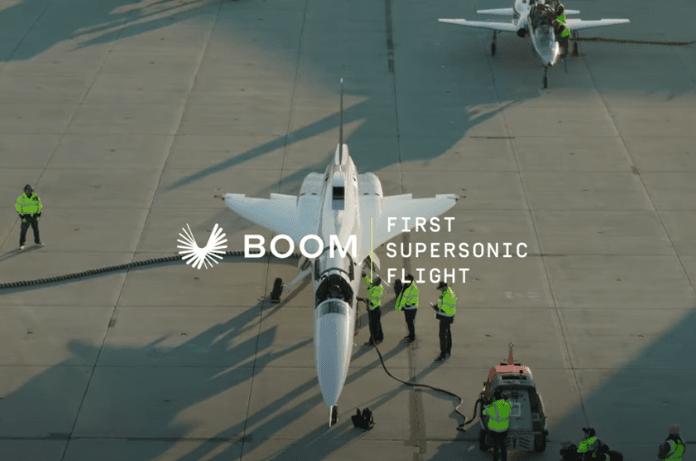Just seconds, Boom Supersonic’s XB-1 prototype plane just made a supersonic in the skies over California’s Mojave desert. And XB-1 became the first privately developed civil aircraft to break the sound barrier. This remarkable achievement signals a potential resurgence of supersonic commercial travel since the retirement of Concorde in 2003.
The US startup’s XB-1 supersonic plane nailed the groundbreaking achievement in its 12 test flights. It cleared Mach 1 and stayed supersonic for about 4 minutes at an altitude of nearly 35,000 feet and reached Mach 1.1. A Mirage F1 jet and a T-38 chase plane closely monitored the XB-1 all throughout the test. Also, they captured the footage of the incredible event.
The former U.S. Navy aviator and Boom’s test pilot Tristan Brandenburg broke the sound barrier twice before getting the navigation command to bring the XB-1 back to base Mojave Air and Space Port.
The former Chief Engineer Greg Krauland said during the Boom’s live streaming on social media, “This is a massive step, building the first civil supersonic jet, right here in America.”
History of Boom Supersonic’s XB-1
Founded in 2014 by Blake Scholl, Boom Supersonic aims to revive and revolutionize supersonic travel. The company’s vision centers on making high-speed flight affordable, sustainable, and accessible. The XB-1, affectionately dubbed the “Baby Boom,” serves as a one-third-scale demonstrator for Boom’s planned commercial airliner, the Overture. The XB-1 is powered by three General Electric CJ610 engines. It is designed to maintain speeds of Mach 2.2, with a range exceeding 1,000 nautical miles.
Over the weekend, Boom CEO Blake Scholl wrote in a social media post that “a lot of work remains to scale up to Overture”. Also, he wrote Overture already has customers in waiting: American Airlines, and Japan Airlines. They have all placed orders for the proposed supersonic aircraft. The company plans to launch the Overture by 2029, with the aircraft designed to carry 64 to 80 passengers. If successful, this could indicate a new era of supersonic travel, making high-speed flights more accessible and efficient.
Conclusion
The successful supersonic flight of the XB-1 is a testament to the advancements in aerospace engineering and the dedication of the Boom Supersonic team. This achievement not only demonstrates the feasibility of privately developed supersonic aircraft but also rekindles the possibility of reducing flight times significantly.
Also, this accomplishment represents a significant leap toward the return of supersonic passenger travel. While challenges remain, the advancements made by Boom Supersonic indicate a promising future. With excellent advancement, the world becomes more connected through faster and more efficient air travel.

